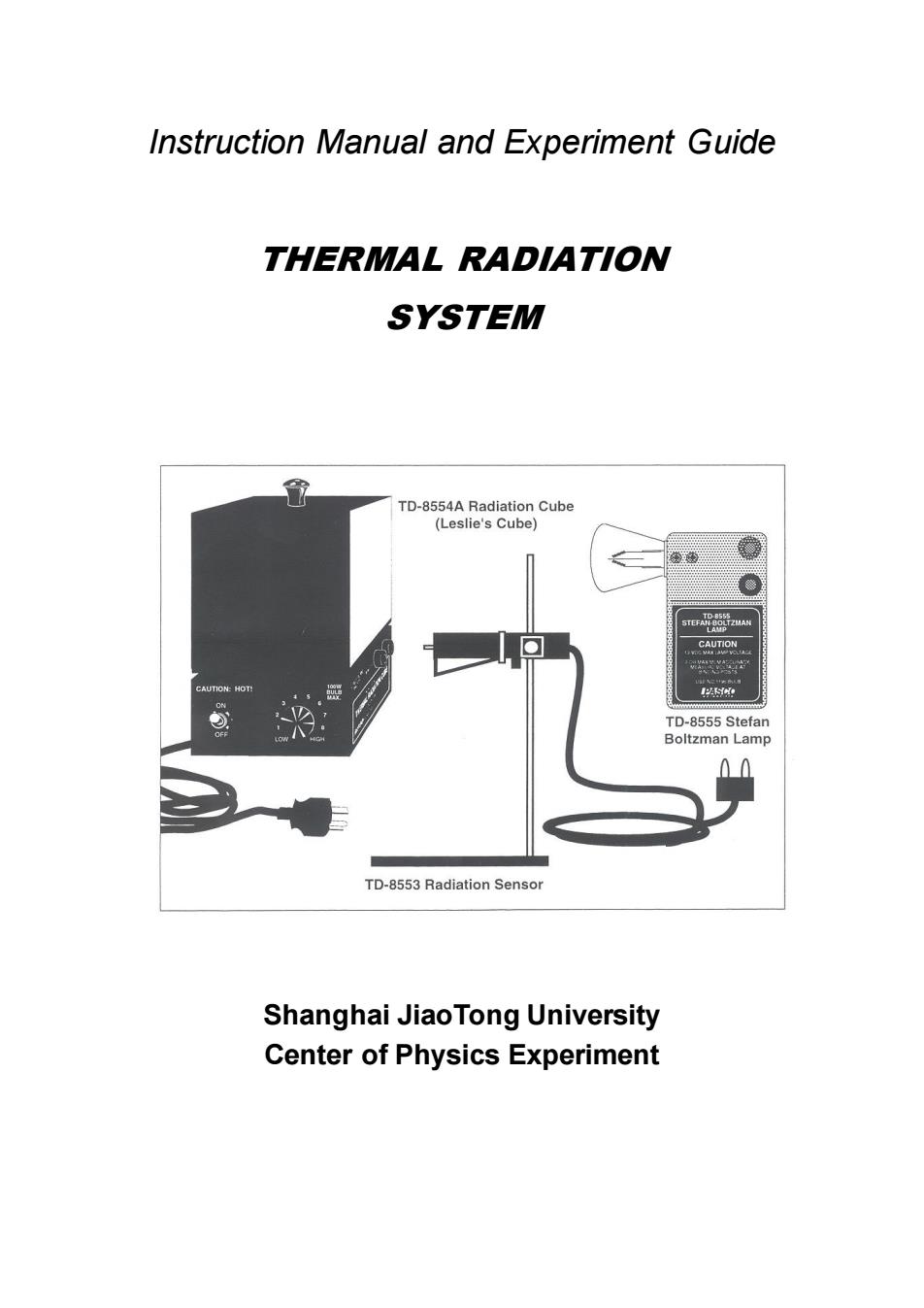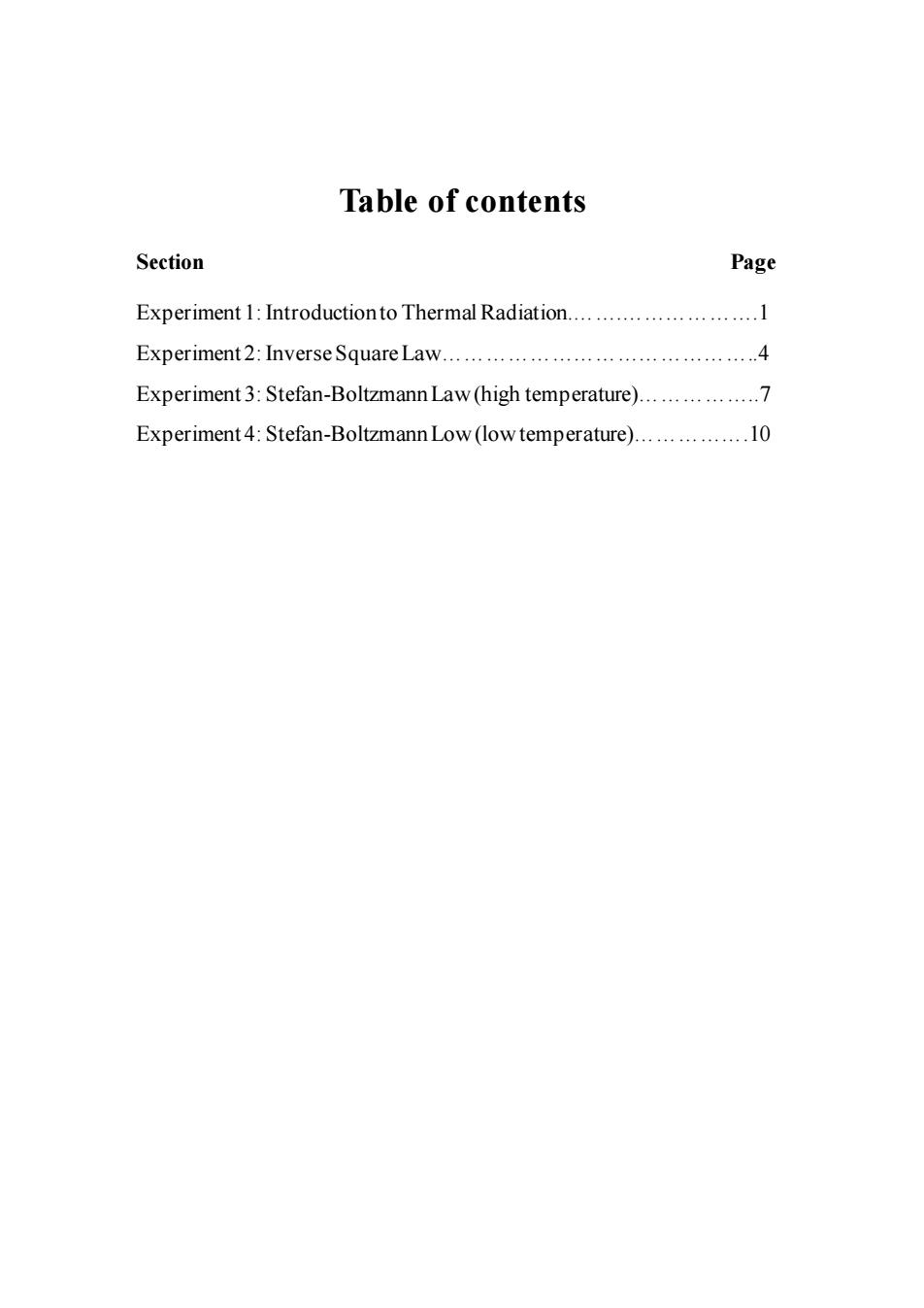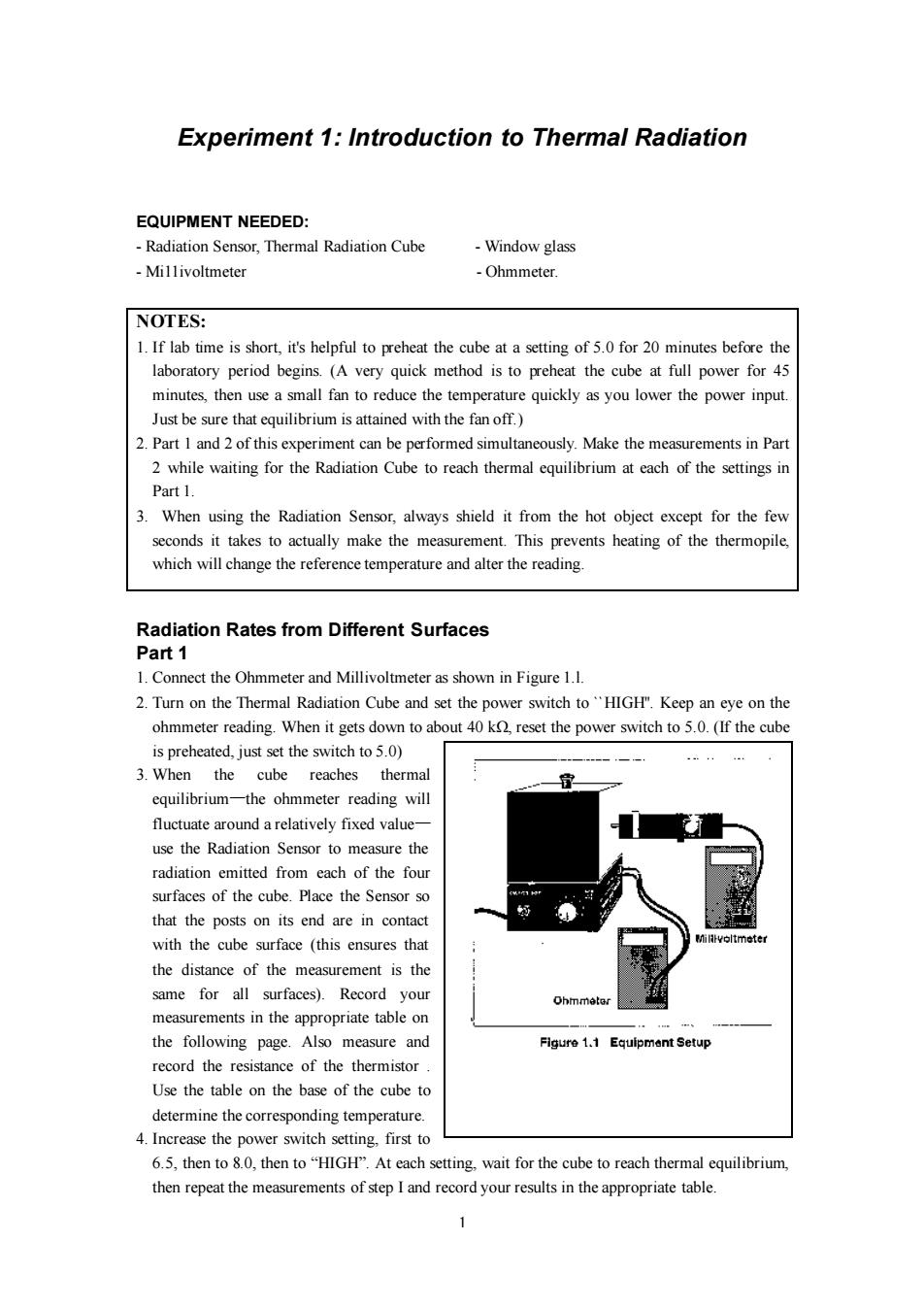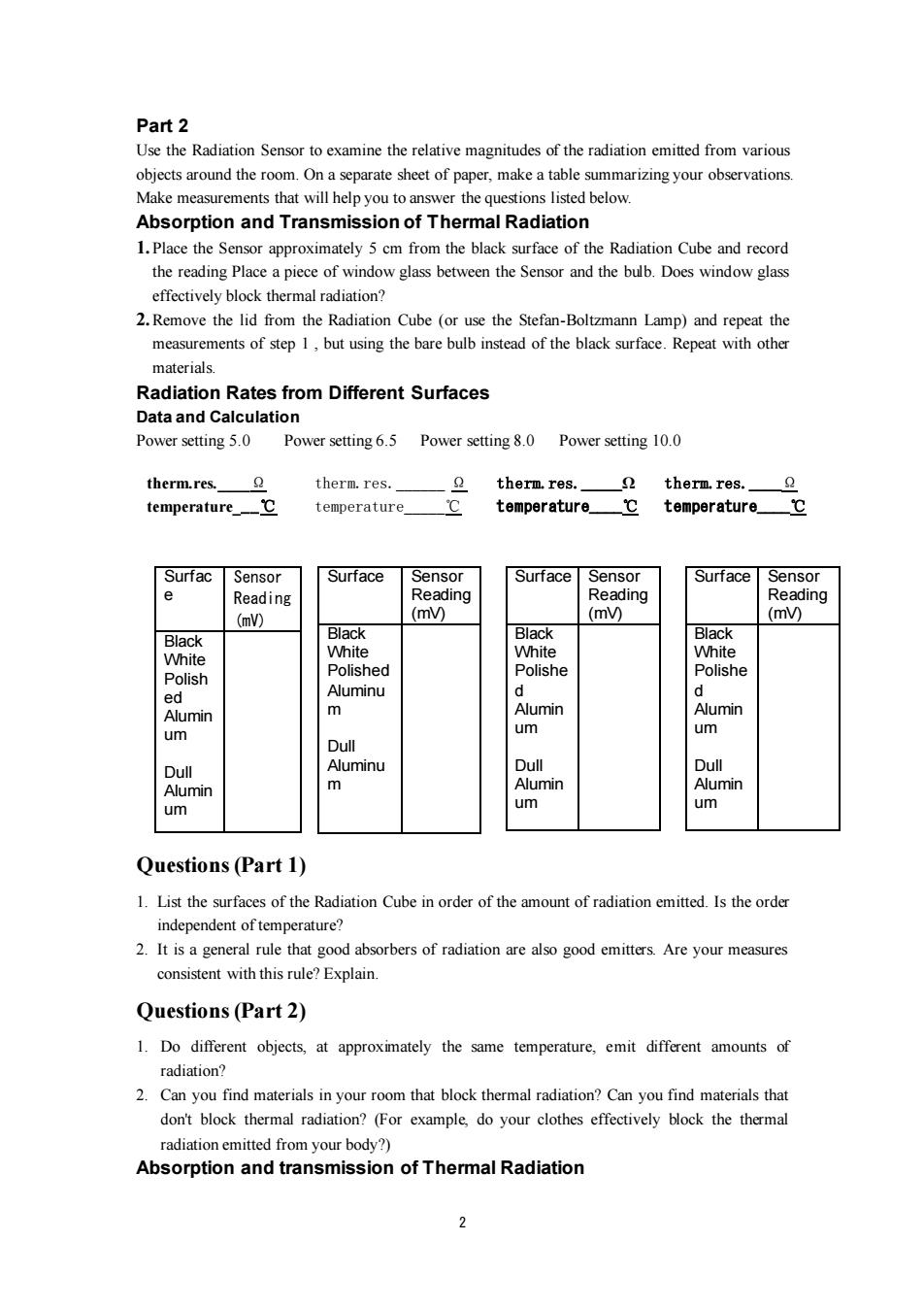
Instruction Manual and Experiment Guide THERMAL RADIATION SYSTEM TD-8554A Radiation Cube (Leslie's Cube) se器wa CAUTION CAUTION:HOT! IISiNe TD-8555 Stefan Boltzman Lamp 0 TD-8553 Radiation Sensor Shanghai JiaoTong University Center of Physics Experiment
Instruction Manual and Experiment Guide THERMAL RADIATION SYSTEM Shanghai JiaoTong University Center of Physics Experiment

Table of contents Section Page Experiment 1:Introductionto Thermal Radiation...........................1 Experiment 2:InverseSquare Law................4 Experiment 3:Stefan-Boltzmann Law (high temperature)................. Experiment4:Stefan-Boltzmann Low(lowtemperature)................10
Table of contents Section Page Experiment 1: Introduction to Thermal Radiation.…….……………….1 Experiment 2: Inverse Square Law……………………………………..4 Experiment 3: Stefan-Boltzmann Law (high temperature)……………..7 Experiment 4: Stefan-Boltzmann Low (low temperature)…………….10

Experiment 1:Introduction to Thermal Radiation EQUIPMENT NEEDED: -Radiation Sensor,Thermal Radiation Cube -Window glass -Millivoltmeter -Ohmmeter. NOTES: 1.If lab time is short,it's helpful to preheat the cube at a setting of 5.0 for 20 minutes before the laboratory period begins.(A very quick method is to preheat the cube at full power for 45 minutes,then use a small fan to reduce the temperature quickly as you lower the power input. Just be sure that equilibrium is attained with the fan off.) 2.Part I and 2 of this experiment can be performed simultaneously.Make the measurements in Part 2 while waiting for the Radiation Cube to reach thermal equilibrium at each of the settings in Part 1. 3.When using the Radiation Sensor,always shield it from the hot object except for the few seconds it takes to actually make the measurement.This prevents heating of the thermopile, which will change the reference temperature and alter the reading. Radiation Rates from Different Surfaces Part 1 1.Connect the Ohmmeter and Millivoltmeter as shown in Figure 1.1. 2.Turn on the Thermal Radiation Cube and set the power switch to"HIGH".Keep an eye on the ohmmeter reading.When it gets down to about 40 k,reset the power switch to 5.0.(If the cube is preheated,just set the switch to 5.0) 3.When the cube reaches thermal equilibrium-the ohmmeter reading will fluctuate around a relatively fixed value- use the Radiation Sensor to measure the radiation emitted from each of the four surfaces of the cube.Place the Sensor so that the posts on its end are in contact with the cube surface (this ensures that Milvoltmeter the distance of the measurement is the same for all surfaces).Record your measurements in the appropriate table on the following page.Also measure and Figure 1.1 Equipmant Setup record the resistance of the thermistor. Use the table on the base of the cube to determine the corresponding temperature. 4.Increase the power switch setting,first to 6.5,then to 8.0,then to"HIGH".At each setting,wait for the cube to reach thermal equilibrium, then repeat the measurements of step I and record your results in the appropriate table
1 Experiment 1: Introduction to Thermal Radiation EQUIPMENT NEEDED: - Radiation Sensor, Thermal Radiation Cube - Window glass - Mi11ivoltmeter - Ohmmeter. NOTES: 1. If lab time is short, it's helpful to preheat the cube at a setting of 5.0 for 20 minutes before the laboratory period begins. (A very quick method is to preheat the cube at full power for 45 minutes, then use a small fan to reduce the temperature quickly as you lower the power input. Just be sure that equilibrium is attained with the fan off.) 2. Part 1 and 2 of this experiment can be performed simultaneously. Make the measurements in Part 2 while waiting for the Radiation Cube to reach thermal equilibrium at each of the settings in Part 1. 3. When using the Radiation Sensor, always shield it from the hot object except for the few seconds it takes to actually make the measurement. This prevents heating of the thermopile, which will change the reference temperature and alter the reading. Radiation Rates from Different Surfaces Part 1 1. Connect the Ohmmeter and Millivoltmeter as shown in Figure 1.l. 2. Turn on the Thermal Radiation Cube and set the power switch to ``HIGH''. Keep an eye on the ohmmeter reading. When it gets down to about 40 kΩ, reset the power switch to 5.0. (If the cube is preheated, just set the switch to 5.0) 3. When the cube reaches thermal equilibrium—the ohmmeter reading will fluctuate around a relatively fixed value— use the Radiation Sensor to measure the radiation emitted from each of the four surfaces of the cube. Place the Sensor so that the posts on its end are in contact with the cube surface (this ensures that the distance of the measurement is the same for all surfaces). Record your measurements in the appropriate table on the following page. Also measure and record the resistance of the thermistor . Use the table on the base of the cube to determine the corresponding temperature. 4. Increase the power switch setting, first to 6.5, then to 8.0, then to “HIGH”. At each setting, wait for the cube to reach thermal equilibrium, then repeat the measurements of step I and record your results in the appropriate table

Part 2 Use the Radiation Sensor to examine the relative magnitudes of the radiation emitted from various objects around the room.On a separate sheet of paper,make a table summarizing your observations. Make measurements that will help you to answer the questions listed below. Absorption and Transmission of Thermal Radiation 1.Place the Sensor approximately 5 cm from the black surface of the Radiation Cube and record the reading Place a piece of window glass between the Sensor and the bulb.Does window glass effectively block thermal radiation? 2.Remove the lid from the Radiation Cube (or use the Stefan-Boltzmann Lamp)and repeat the measurements of step 1,but using the bare bulb instead of the black surface.Repeat with other materials Radiation Rates from Different Surfaces Data and Calculation Power setting 5.0 Power setting 6.5 Power setting 8.0 Power setting 10.0 therm.res.】 2 therm.res. therm.res. therm.res. temperature_℃ temperature temperature_℃ temperature.℃ Surfac Sensor Surface Sensor Surface Sensor Surface Sensor 0 Reading Reading Reading Reading (mV) (m) (mV) (m) Black Black Black Black White White White White Polished Polishe Polishe Polish ed Aluminu d d Alumin m Alumin Alumin um um um Dull Dull Aluminu Dull Dull Alumin m Alumin Alumin um um um Questions(Part 1) 1.List the surfaces of the Radiation Cube in order of the amount of radiation emitted.Is the order independent of temperature? 2.It is a general rule that good absorbers of radiation are also good emitters.Are your measures consistent with this rule?Explain. Questions(Part 2) 1.Do different objects,at approximately the same temperature,emit different amounts of radiation? 2.Can you find materials in your room that block thermal radiation?Can you find materials that don't block thermal radiation?(For example,do your clothes effectively block the thermal radiation emitted from your body?) Absorption and transmission of Thermal Radiation
2 Part 2 Use the Radiation Sensor to examine the relative magnitudes of the radiation emitted from various objects around the room. On a separate sheet of paper, make a table summarizing your observations. Make measurements that will help you to answer the questions listed below. Absorption and Transmission of Thermal Radiation 1. Place the Sensor approximately 5 cm from the black surface of the Radiation Cube and record the reading Place a piece of window glass between the Sensor and the bulb. Does window glass effectively block thermal radiation? 2.Remove the lid from the Radiation Cube (or use the Stefan-Boltzmann Lamp) and repeat the measurements of step 1 , but using the bare bulb instead of the black surface. Repeat with other materials. Radiation Rates from Different Surfaces Data and Calculation Power setting 5.0 Power setting 6.5 Power setting 8.0 Power setting 10.0 Questions (Part 1) 1. List the surfaces of the Radiation Cube in order of the amount of radiation emitted. Is the order independent of temperature? 2. It is a general rule that good absorbers of radiation are also good emitters. Are your measures consistent with this rule? Explain. Questions (Part 2) 1. Do different objects, at approximately the same temperature, emit different amounts of radiation? 2. Can you find materials in your room that block thermal radiation? Can you find materials that don't block thermal radiation? (For example, do your clothes effectively block the thermal radiation emitted from your body?) Absorption and transmission of Thermal Radiation therm.res.____Ω temperature___℃ therm.res.______ Ω temperature_____℃ therm.res._____Ω temperature____℃ therm.res.____Ω temperature____℃ Surfac e Sensor Reading (mV) Black White Polish ed Alumin um Dull Alumin um Surface Sensor Reading (mV) Black White Polished Aluminu m Dull Aluminu m Surface Sensor Reading (mV) Black White Polishe d Alumin um Dull Alumin um Surface Sensor Reading (mV) Black White Polishe d Alumin um Dull Alumin um

Questions 1.What do your results suggest about the phenomenon of heat loss through windows? 2.What do your results suggest about the Greenhouse Effect?
3 Questions 1. What do your results suggest about the phenomenon of heat loss through windows? 2. What do your results suggest about the Greenhouse Effect?